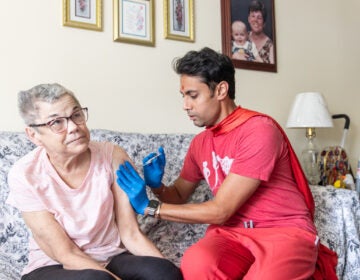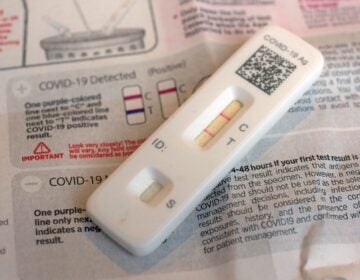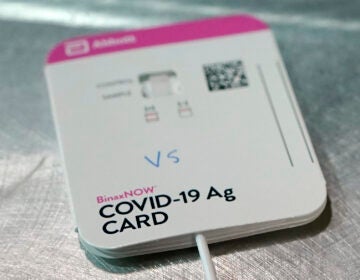Philly officials ‘cautiously optimistic’ over falling COVID case counts, fatalities
Coronavirus case counts and fatalities have fallen in recent weeks, though Philadelphia officials encouraged residents to double down on physical distancing measures.
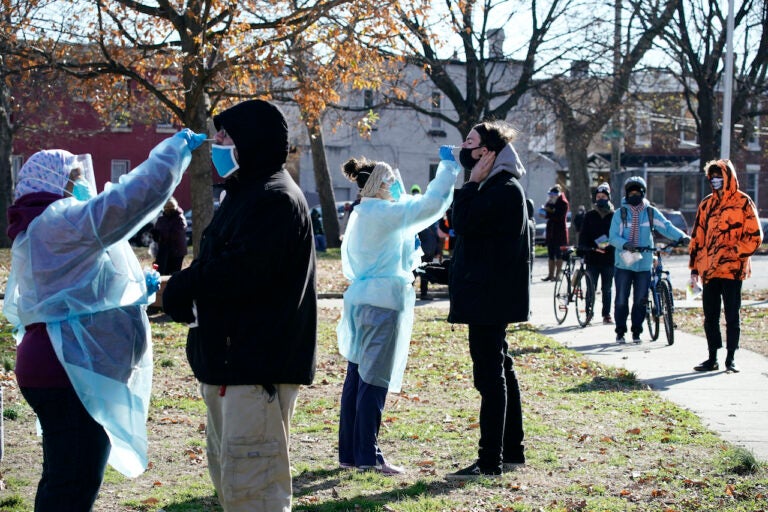
Registered nurses swab patients during testing for COVID-19 organized by Philadelphia FIGHT Community Health Centers, Thursday, Dec. 10, 2020, at Mifflin Square Park in South Philadelphia. (AP Photo/Matt Slocum)
Ask us about COVID-19: What questions do you have about the current surge?
Pennsylvania reported 8,545 new cases of COVID-19 on Tuesday, bringing the statewide total to 622,349 since the start of the pandemic. As of 11:59 p.m. on Monday, the state reported 267 new fatalities, for a total death toll of 15,353.
There are 5,995 individuals currently hospitalized with COVID-19, close to double the peak in the spring. Of that number, 1,174 are in the intensive care unit. The majority of hospitalizations and deaths have occurred in patients 65 and older.
Philadelphia reported 822 new cases on Tuesday (not counting an additional 103 probable new cases) since the previous day, for a total of 90,351 cases of COVID since the start of the pandemic. The city also registered 38 new deaths, for a citywide total of 2,406.
In a press conference, Philadelphia Health Commissioner Dr. Tom Farley said the latest numbers offer reason for cautious optimism.
“I have better news today,” he said. “Our case counts have been falling for the past three weeks, but the case counts are still high and we still need to be careful.”
Over the week spanning Dec. 20-25, Philadelphia averaged 501 cases per day, along with a 9.0% positive test rate. That’s lower than the previous week, which averaged 679 cases per day, and a 9.4% positive test rate (though Farley added that fewer tests were performed last week because of the holiday).
Fatalities have also declined — from 94 deaths the week of Dec. 6, to 69 deaths the week of Dec. 13, to 38 the week of Dec. 20. The latest count will likely rise as late reports of deaths continue coming in, but, Farley said, “the fact that these numbers are decreasing, even though they’re high, is a sign that the lower case counts may be leading to fewer deaths, which is a positive sign.”
The number of hospitalized patients clocked in Tuesday at 784, lower than in previous weeks.
New COVID variant likely ‘somewhere in the U.S. right now’
Farley also addressed a new variant of COVID-19 that was first detected in the United Kingdom, and has since spread to several countries in Europe, as well as Japan and Canada.
The new variant can’t be detected using regular coronavirus tests — instead, it requires a special diagnostic called genome sequencing, which is a more complicated process.
“That test has only been done on about 50,000 of the people who have positive tests in the United States since the beginning of the epidemic,” Farley said. “So I would say it’s likely this new variant is somewhere in the United States right now. It’s simply not been recognized yet.”
The CDC is coordinating labs across the country to test samples of new positives for the variant.
Though he encouraged Philadelphians to double down on physical distancing measures, he said reports that the new variant is 56% more contagious are as yet unconfirmed.
“It’s not proven yet that the new variant really is more easily transmitted,” Farley said. “At this point, I would still describe that as speculation. There are other possible reasons for the surge in the United Kingdom.”
Scientists believe that the new variant doesn’t cause more serious infections, and should be prevented by existing vaccines.
City’s ‘safer at home’ restrictions will continue through Jan. 15
Philadelphia will maintain its Safer at Home restrictions — which bar indoor restaurant dining, indoor gatherings and events, theaters, casinos, in-person instruction at universities, and indoor organized sports — through Jan. 15, Health Commissioner Tom Farley said on Tuesday.
The restrictions, which were instituted on Nov. 20, are designed to minimize the most risky situations for the transmission of COVID — and so far, Farley says, they’ve been working.
Since the restrictions started, Philadelphia’s seven-day average case rates have fallen by 41%, according to state data. In the same time period, state-wide rates have risen 16%. Philadelphia County went from having the highest case rates in southeast Pennsylvania to the lowest.
The timeline for relaxing those restrictions corresponds to expected spikes in infection resulting from Christmas and New Year’s gatherings.
“These two spikes may run together and they may feed off of each other,” Farley said. “We won’t see the end of them until about Jan. 15.”
If case rates don’t rise more than expected over the next few days, Farley said, the city will proceed with relaxing state restrictions on less risky settings, which are set to expire on Jan. 4. That’ll mean reopening museums, outdoor sports, gyms, high schools, and outdoor catered events, though Farley said safety measures — like requiring masks and limiting the number of people allowed to participate — will continue.
Most important right now, Farley said, is that people maintain physical distancing through the holidays.
“No indoor gatherings – don’t get together with people outside of your household,” Farley said. “If you want to get together, do it outside with masks. Don’t go to New Year’s Eve parties. Celebrate with your immediate household members — only the people you live with every day, not with relatives or friends who don’t live with you. And it doesn’t matter if they’ve been tested — don’t get together with people outside of your household is particularly important right now.”
Vaccinations have begun — but for most people, it’ll take awhile
More than 18,000 Philadelphians have received their first of two doses of the newly available COVID vaccines, Farley said on Tuesday.
“It really is exciting to get to this point,” he said. “It’s been a tough epidemic for us. So this is really just great to be at this turning point.”
Both vaccines — Pfizer’s and Moderna’s — require two shots, several weeks apart. The first shot offers roughly 50% protection, and the second 95% protection, Farley said.
The first round of vaccinations, which are still being carried out, are being given to people who work in healthcare settings and are exposed to COVID-19.
This week, the federal government allocated 8,800 doses of the Pfizer vaccine, and 9,200 doses of the Moderna vaccine to Philadelphia. The city will continue to receive roughly the same number of doses over the next two weeks.
“Then after that, we’ll find out,” Farley said. “We just don’t know what we’ll get after that.”
While the initial phase of vaccinations has focused on healthcare workers at hospitals, the city will soon expand to non-hospital-based healthcare workers, including behavioral health facilities.
This week, pharmacies contracted by the federal government will start providing on-site vaccinations to nursing home staff and residents.
“The number of doses we’re receiving is small, so people who want to be vaccinated, including healthcare workers, are going to have to be patient in getting the vaccine,” he said. “Over time, everyone who wants the vaccine will get it, but it’s going to take us a long time to make it available to people.”
The city Department of Public Health has posted a vaccination dashboard, where people can track the number and location of vaccinations that have been dispensed.
Farley debunks COVID vaccine rumors
In the wake of a recent viral story about an ER nurse who presented with COVID-19 six days after receiving a vaccination, Health Commissioner Farley addressed fears concerning vaccines.
“The vaccine — 95% is a fabulous vaccine,” Farley said, referring to the vaccines’ 95% efficacy rates. “That’s a very, very protective vaccine — but it’s not 100% perfect. Okay. There’s going to be a few people who it won’t protect — not a reason not to take it.”
Farley explained that the first dose of the vaccines should provide around 50% protection, which rises to 95% after the second dose.
“We would expect that some people, if they happened to be exposed right around the time that they were vaccinated, to come back positive within the next few days,” Farley said. “We’d expect fewer people — but non-zero — they might come back positive even, you know, a month after they get that first dose. And a very small number of people, even if they get two doses, might still get the infection.”
Farley also addressed another rumor about the vaccine — namely that it contains some version of the COVID-19 virus itself.
“The vaccine does not include the virus,” Farley said. “There’s no virus in the vaccine at all. There’s no risk of getting the infection from the vaccine.”
Instead, Farley said, the vaccine contains “instructions” on how to make a very specific protein that COVID uses to attack the body’s cells.
“The body recognizes that protein as being foreign, something that shouldn’t be there,” Farley said. “And then it develops an immune response to that protein. Once the body has those antibodies to the protein, then when the real virus comes along, it recognizes it immediately and it kills off that virus.”

Get daily updates from WHYY News!
WHYY is your source for fact-based, in-depth journalism and information. As a nonprofit organization, we rely on financial support from readers like you. Please give today.


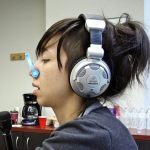

![CoronavirusPandemic_1024x512[1]](https://whyy.org/wp-content/uploads/2020/03/CoronavirusPandemic_1024x5121-300x150.jpg)
